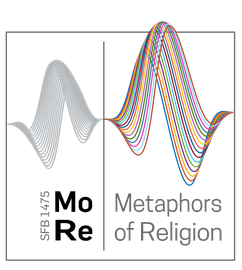Research Profile
Religious meaning-making occurs in and through metaphors. In metaphors, meaning is transferred from one semantic domain to another. Religion, which cannot directly address its ultimate subject (the transcendent), is dependent on this procedure. The CRC seeks to more thoroughly understand this process theoretically and grasp it methodologically to research its semantic forms empirically and comparatively. The shapes religion takes as a socio-cultural phenomenon are thus better understood and central developments within specific religious traditions become more tangible. The CRC contributes to the historiography of religions, on the one hand, and to answering systematic questions in the comparative study of religions, on the other.
While extensive research on metaphors in religious texts exists, the CRC’s novel approach lies, first, in its systematic focus on metaphoricity as the central principle of religious meaning-making. Religion is understood as the form of communication that has the function of coping with ultimate contingency by means of the transcendence/immanence distinction. In this paradoxical process, the metaphor is used to infer the unknown (target domain) from known means (source domain) and in this way creates religious meaning.
Second, the CRC’s multidisciplinary composition allows for comparative studies on an unprecedented scale in the field. The subprojects cover multiple religious traditions, including Christianity, Islam, Judaism, Zoroastrianism, Jainism, Buddhism, and Daoism. Their geographical foci cover Europe, the Near and Middle East, South, Central, and East Asia. The time frame ranges from 3,000 BCE to the present day. The structuring of the subprojects in three sections is based on the elementary linguistic domains, ‘The Physical’, ‘The Mind’, and ‘The Social.’
Thirdly, the CRC is integrated through a shared methodological workbench, most notably an instrument for metaphor annotation used in all subprojects, complementing hermeneutic interpretation on the one hand and computational analysis on the other. In pilot projects, computational methods will be further developed, tailored to the CRC’s needs, and gradually implemented in further subprojects. The research corpora will be integrated into a shared repository and all identified metaphors will be linked with a ‘Thesaurus of Religious Metaphors’ (TRM). This will be both a central result of the CRC and a crucial tool for further comparative work across the subprojects and beyond.
In the first funding phase, the CRC will concentrate on the empirical analysis of textual material. However, a working group will explore the relationship between metaphors and material objects and develop methodological approaches. In future funding phases of this CRC, we also aim to advance the theoretical conceptualization in the broader context of religious sign processes and develop new and innovative tools for their analysis.

